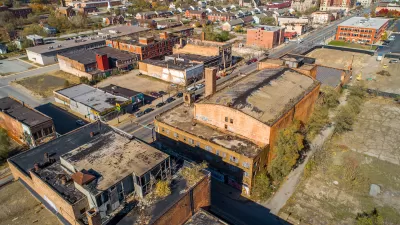More than 900 Chinese cities are continuing to plan for growth even as their populations shrink.

Nearly one-third of Chinese cities are losing population—more than anywhere else in the world, according to a new study from Tsinghua University. That finding, obtained by monitoring nighttime lights in more than 3,300 cities over three years, conflicts with official data anticipating urban growth throughout the country.
"The Chinese cities under the greatest pressure of shrinking include those heavily dependent on natural resources, such as the coal mining town of Hegang in Heilongjiang province," Sidney Leng reports in South China Morning Post. Many are located in China's rust belt.
A review of 60 cities' urban development plans showed that many municipalities are still relying on "inflated" projections, leading them to undertake major infrastructure and development projects designed to accommodate population growth that is not likely to occur.
Researchers worry that this trend marks a recipe for urban decay, leading to empty high-rises and unused industrial developments. "Many landscapes in the US rust belt could be the future of some of China’s shrinking cities," one researcher told the Post.
FULL STORY: Almost one-third of Chinese cities are shrinking, but urban planners told to keep building

Alabama: Trump Terminates Settlements for Black Communities Harmed By Raw Sewage
Trump deemed the landmark civil rights agreement “illegal DEI and environmental justice policy.”

Study: Maui’s Plan to Convert Vacation Rentals to Long-Term Housing Could Cause Nearly $1 Billion Economic Loss
The plan would reduce visitor accommodation by 25% resulting in 1,900 jobs lost.

Why Should We Subsidize Public Transportation?
Many public transit agencies face financial stress due to rising costs, declining fare revenue, and declining subsidies. Transit advocates must provide a strong business case for increasing public transit funding.

Paris Bike Boom Leads to Steep Drop in Air Pollution
The French city’s air quality has improved dramatically in the past 20 years, coinciding with a growth in cycling.

Why Housing Costs More to Build in California Than in Texas
Hard costs like labor and materials combined with ‘soft’ costs such as permitting make building in the San Francisco Bay Area almost three times as costly as in Texas cities.

San Diego County Sees a Rise in Urban Coyotes
San Diego County experiences a rise in urban coyotes, as sightings become prevalent throughout its urban neighbourhoods and surrounding areas.
Urban Design for Planners 1: Software Tools
This six-course series explores essential urban design concepts using open source software and equips planners with the tools they need to participate fully in the urban design process.
Planning for Universal Design
Learn the tools for implementing Universal Design in planning regulations.
Smith Gee Studio
Alamo Area Metropolitan Planning Organization
City of Santa Clarita
Institute for Housing and Urban Development Studies (IHS)
City of Grandview
Harvard GSD Executive Education
Toledo-Lucas County Plan Commissions
Salt Lake City
NYU Wagner Graduate School of Public Service





























